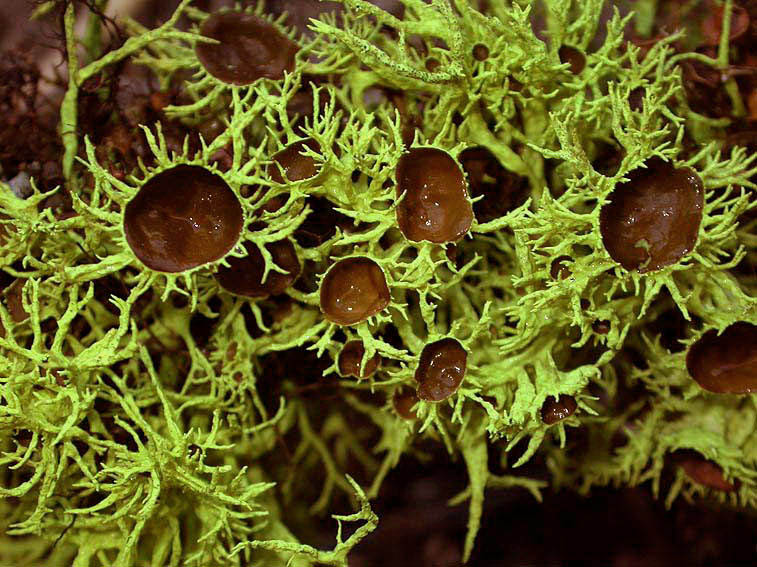
Small Inoperculate Cups - Leotiomycetes p.p.
I am assuming that most cup fungi are saprophytic, but I don't know if that has been well studied. Many of the species can be found year round, or at least in spring and fall. Notable exceptions will be given. As usual, they may be found on conifers or both conifers and hardwoods, unless specified.
Inoperculate means that the asci (the microscopic structures inside which the spores grow after which the Ascomycota get their name) do not have a lid that opens up to release the spores. This is very difficult to see under a microscope, but it is a good indicator of which mushrooms are related to each other. This indicates that the morels, large cups and operculate small cups are related to each other, but the earth tongues are related the mushrooms on this page.
Exceptions - the following species are often found on wood but are actually operculate cup fungi and found on that page as well.
Scutellinia - yellow to orange to red cups or discs with eyelash hairs on the margin. <2cm.
Pachyella babingtonii - red- to yellow-brown translucent disc on wet wood. <1cm.
Miladina lecithina - brighter yellow-orange, <5mm.
Pithya vulgaris - orange short stemmed discs on fir twigs. <1cm.
P. cupressina - on cedar and juniper twigs. <5mm. Chloroscypha has a longer stem.
Pseudopithyella minuscula - scarlet, <3mm, southern species.
Basidiomycota - there are just a few cup-shaped fungi that are not Ascomycota at all, but Basidiomycota. You would never know this unless you examine them under a microscope or recognize them from these pictures. Not only are they Basidiomycota, but most are closely related to the gilled mushrooms! Over the years they have lost their gills kind of like you stopped using your appendix. All except Aleurodiscus may be distantly related to Marasmius. Most are rarely found, possibly because of their minuscule size and confusion with the small cup-like Ascomycota found on the rest of this page. They are found on wood and are saprophytic. Most fruit year round.
Henningsomyces candidus group - flaring white straws, less than 1/2mm wide!
Flagelloscypha - hairy white cups (not so tall) on woody debris.
Merismodes - hairy ochre rimmed cups, tightly clustered, deciduous twigs.
Lachnella alboviolascens - purple cups with a white hairy fringe, 1cm or so, on deciduous stems. Resembles Lachnum.
Lachnella villosa - much smaller, <1mm, mostly white and even more easily confused with Lachnum.
Aleurodiscus grantii - salmon pink, discs with a furry rim. Sometimes irregular shaped and not disc-like, but a crust. <5mm. Russulales.
Key to Small Inoperculate Cups:
Colourful cups with non-hairy rims and none or a short stem or boring cups with non-hairy rims and no stems.
Cups on dung or soil (that don't follow the rules and so are keyed out in the Operculate Cups page too).
Helotiales
Colourful or boring, smooth rimmed cups or discs (without hairs) on wood, stemless or if colourful, possibly with a short stem.
Chlorociboria aeruginascens - blue cups, <5mm, short off-centre stem, somewhat irregular shape, blue flesh.
Chlorociboria mycelium actually turns wood blue! (See Phanerochaete for one that stains wood red!)
Orbilia - orange translucent discs, sometimes pallid, <1mm. They may belong in their own class!
Mollisia cinerea (
Belonopsis graminea - dark brown with pale rim, on grasses.
Vibrissea decolorans/
Hymenoscyphus virgultorum/
Chloroscypha (Kriegeria) alutipes - yellow cups with variable length stem on Incense-cedar that turn black. Southern species.
Lanzia luteovirescens - more colourful than the brown Sclerotiniaceae it's actually related to, below.
Sclerotiniaceae - Brownish (rarely more colourful) smooth rimmed cups or discs with long stems on woody debris (cones, needles, leaves or twigs). The species are separated by the substrate they are growing on. These are different enough from the other group that they will be separated from the Helotiales into a new order. It may be of interest that Botrytis cinerea, the noble rot fungus that is cultured to make some expensive desert wines, is an anamorph (asexual stage) fungus related to this group.
Rutstroemia petiolorum - similar to Cibora spp, this species usually on oak leaves. Fall.
Monolinia species usually arise from plant fruits.
Sclerotinia veratri - on Veratrum corn-lily. This genus has a sclerotium (ball of nutrients) at its base (often inside the substrate). Spring.
Hyaloscyphaceae - colourful HAIRY rimmed cups or discs on wood and woody debris, stemless or with a short stem.
Lachnum (Dasyscyphus/
Lachnum virgineum - all white hairy cups, short stem on blackberry and other hardwoods. <2mm.
Dasyscyphella spp. are similar.
Velutarina rufo-olivacea - olive tones on disc, rusty brown powder underneath, hardwood. (Not truly hairy, thus actually in the Helotiaceae).
Polydesmia pruinosa - white cushions with subtle hairs easily overlooked, <0.5mm, parasitic on Hypoxylon and other flasks.
Lachnellula agassizii - similar to Lachnum, orange discs with white hairs on conifers, 1-4mm.
L.
occidentalis/
Other species in habitats where operculate cup fungi are normally found, so therefore also mentioned on that page:
Thelebolus stercoreus - found on dung, <0.25mm, smooth, yellow-brown with a single protruding ascus with >1,000 spores.
Coprotus - also pale yellow on dung without marginal hairs and <1mm.
Discinella boudieri - brown disc <1cm, on bare soil, less colourful than most operculates found on the ground, except for the usually larger Peziza.